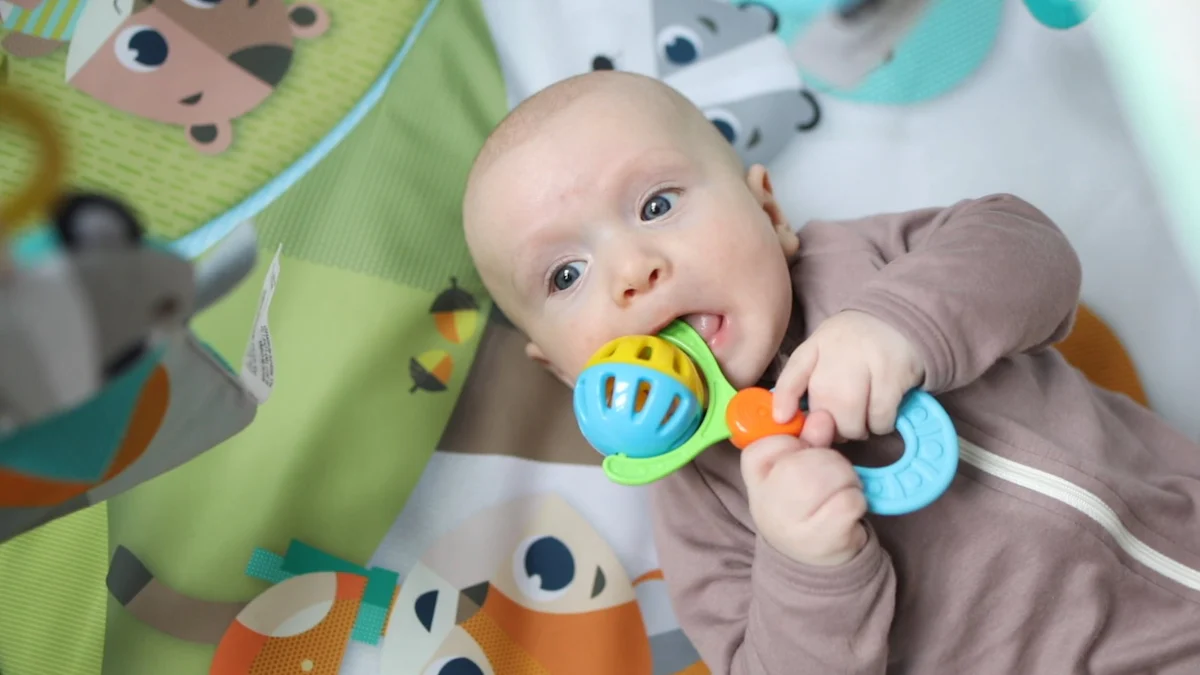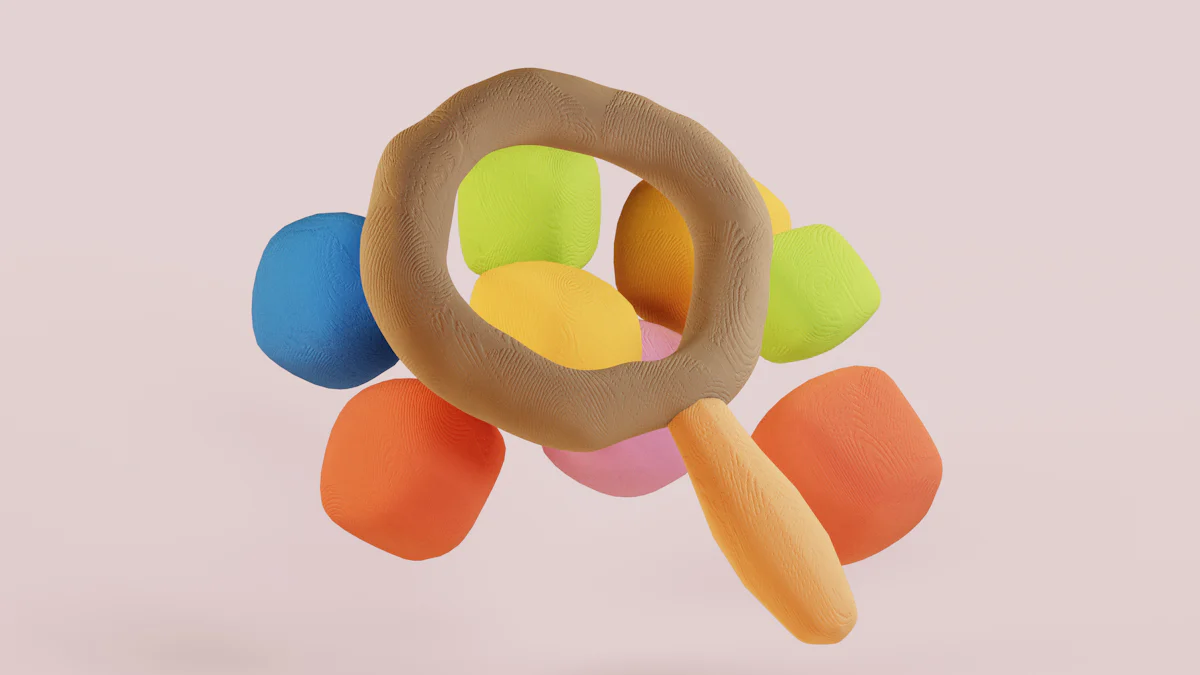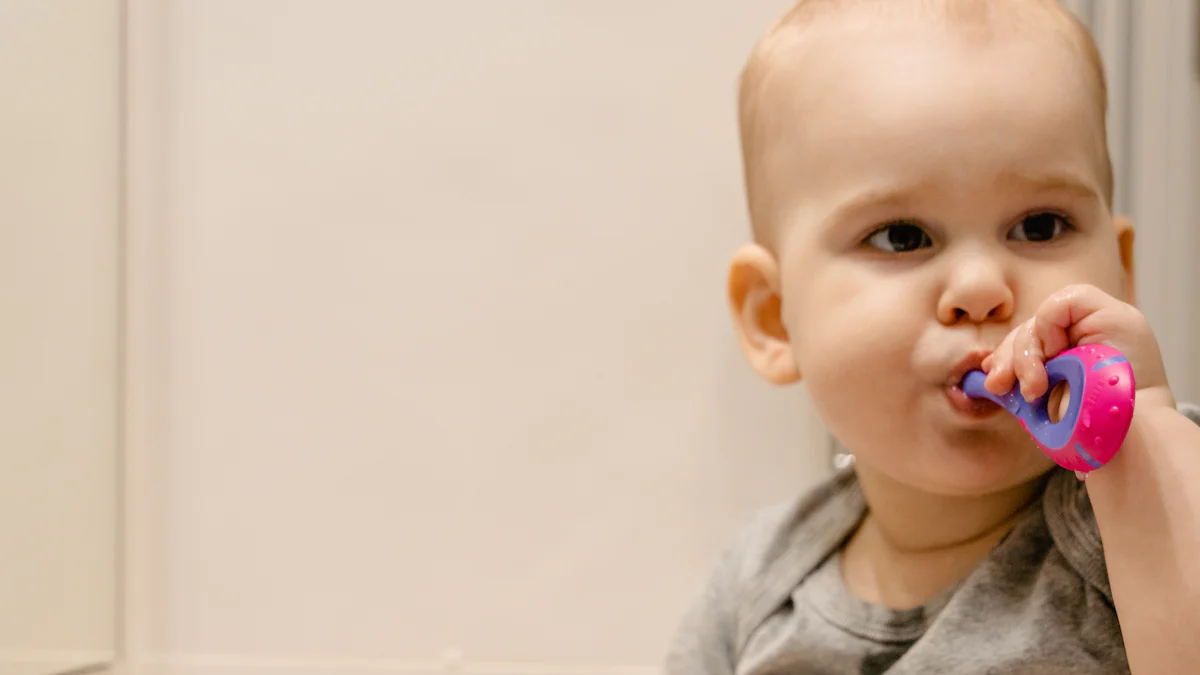Are silicone teethers bad?

When your baby starts teething, you want something safe and soothing for their gums. Silicone teethers are a popular choice because they’re made from food-grade silicone, which is free from harmful chemicals like BPA and phthalates. Unlike some other materials, they don’t leach toxins into your baby’s mouth.
Scientists found that many non-food-grade teethers released harmful chemicals like BPA, parabens, and antimicrobials into water during testing. Even products labeled "BPA-free" or "non-toxic" weren’t always safe.
Choosing high-quality silicone teethers ensures your baby gets relief without exposure to these risks.
Key Takeaways
- Silicone teethers are safe because they use food-grade silicone. They do not have harmful chemicals like BPA or phthalates.
- These teethers last long and are simple to clean. Parents can wash them with soap and water or use a dishwasher.
- Look for safety labels like FDA or EN71 when buying. This ensures the teethers follow strict safety rules.
What Are Silicone Teethers?

Definition and Composition
Silicone teethers are small, chewable items designed to soothe your baby’s gums during teething. They’re made from food-grade silicone, a material known for its safety and durability. This type of silicone is free from harmful chemicals like BPA, PVC, and phthalates, making it a safe choice for babies.
The soft yet sturdy texture of silicone teethers provides gentle relief for sore gums. Unlike some other materials, silicone doesn’t absorb odors or flavors, so it stays fresh even after repeated use. Many silicone teethers are also heat-resistant, which means you can safely clean them in boiling water or a dishwasher.
Why Parents Choose Silicone Teethers
You might wonder why silicone teethers are so popular among parents. Here are some key reasons:
- They’re non-toxic and safe for babies to chew on.
- Their durability ensures they last through the teething phase without breaking or wearing out.
- Cleaning them is a breeze. You can wash them with soap and water or toss them in the dishwasher.
- The flexibility and soft texture make them comfortable for your baby to use.
- Many parents appreciate their eco-friendliness compared to plastic alternatives.
These benefits make silicone teethers a practical and reliable choice for soothing your baby’s teething discomfort. Plus, they come in various shapes and colors, adding a fun element to your baby’s teething experience.
Benefits of Silicone Teethers
Non-Toxic and Baby-Safe
When it comes to your baby’s safety, silicone teethers are a top choice. They’re made from food-grade silicone, which is free from harmful chemicals like BPA, phthalates, PVC, and lead. This means you don’t have to worry about toxins leaching into your baby’s mouth.
Silicone teethers also meet strict safety standards, including FDA, CPSC, and EN71 certifications. These ensure the materials are safe for oral use and free from choking hazards. Plus, silicone is non-porous, so it resists bacteria, mold, and mildew. This makes it a hygienic option for your little one.
Durable and Easy to Clean
Silicone teethers are built to last. They can handle extensive chewing without breaking or wearing out. Unlike wooden teethers, they won’t splinter, making them a safer option for active teething babies.
Cleaning is simple too. You can wash them with soap and water or toss them in the dishwasher. Some parents even sterilize them in boiling water. This durability and ease of cleaning make silicone teethers a practical choice for busy parents.
Gentle and Soothing for Gums
Teething can be tough on your baby, but silicone teethers offer relief. Their soft, chewy texture provides gentle pressure on inflamed gums, helping to ease discomfort. Silicone mimics the feel of skin, making it soothing for sensitive gums while still firm enough to massage them.
Experts agree that the pliable nature of silicone promotes healthy oral development. Babies can chew comfortably, which helps them through the teething phase.
Available in Various Designs and Colors
Silicone teethers aren’t just functional—they’re fun too! You’ll find them in a variety of shapes, like geometric patterns or adorable animal designs. These shapes are easy for babies to grasp, making them user-friendly.
Parents also love the vibrant colors and textures that engage their baby’s senses. Modern designs combine safety with aesthetic appeal, making silicone teethers a favorite among families. Whether you prefer playful or minimalist styles, there’s something for everyone.
Drawbacks of Silicone Teethers
Higher Cost Compared to Other Materials
Silicone teethers often come with a higher price tag compared to teethers made from materials like plastic or rubber. This is because food-grade silicone is a premium material that undergoes rigorous testing to ensure safety. While the durability of silicone teethers can justify the cost, it might still feel like a significant upfront expense for some parents. If you’re on a tight budget, this could be a factor to consider.
Environmental Concerns (Non-Biodegradable)
Although silicone teethers are durable, their environmental impact raises concerns. Silicone is non-biodegradable, meaning it can persist in landfills for hundreds of years. Here’s a quick look at how silicone compares to biodegradable options:
| Aspect | Impact |
|---|---|
| Landfill Space | Non-biodegradable silicone occupies landfill space for decades. |
| Marine Pollution | Silicone items can contribute to marine pollution, harming aquatic life. |
| Resource Use | Persistent silicone waste necessitates ongoing resource extraction for replacements. |
On the bright side, the longevity of silicone teethers reduces the need for frequent replacements, which can help minimize waste over time.
Risks of Low-Quality or Counterfeit Products
Not all silicone teethers are created equal. Low-quality or counterfeit products can pose serious risks to your baby. Some may contain harmful additives like dyes or fragrances, which could leach chemicals into your baby’s mouth. Others might have small parts that present choking hazards. To avoid these risks, always check for certifications like FDA approval and ensure the teether is age-appropriate.
Overuse and Hygiene Issues
While silicone teethers are easy to clean, improper maintenance can lead to hygiene problems. If not washed regularly, they can harbor bacteria or mold, which could harm your baby. Overuse is another concern. Prolonged chewing on teethers might delay your baby’s transition to other oral development activities, like learning to chew solid foods. To prevent this, monitor your baby’s usage and clean the teether frequently.
Silicone Teethers vs Other Materials

Silicone vs Wood
When comparing silicone teethers to wooden ones, both have their strengths. Wooden teethers are natural and biodegradable, making them an eco-friendly choice. However, they require more effort to clean and may not offer the same versatility as silicone. Silicone teethers, on the other hand, are dishwasher-safe and can even be sterilized.
Here’s a quick breakdown to help you decide:
| Feature | Wooden Teethers | Silicone Teethers |
|---|---|---|
| Safety | Non-toxic, free from harmful chemicals | BPA-free, lead-free, phthalate-free, non-toxic |
| Durability | Sturdy, can withstand a lot of chewing | Durable, withstands lots of chewing and drool |
| Maintenance | Requires more effort to clean | Easy to clean, dishwasher safe, can be sterilized |
| Environmental Impact | Biodegradable, environmentally friendly | Not biodegradable, but made from food-grade silicone |
| Versatility | Limited design options | Versatile designs, can be frozen for extra soothing |
If you’re looking for something easy to maintain and versatile, silicone teethers might be the better choice.
Silicone vs Rubber
Rubber teethers are another popular option, but how do they stack up against silicone? Both materials are soft and gentle on your baby’s gums. However, silicone teethers are hypoallergenic, while some babies may develop allergies to natural rubber. Silicone also resists bacteria and odors, making it easier to clean.
Here’s a side-by-side comparison:
| Feature | Silicone Teethers | Rubber Teethers |
|---|---|---|
| Flexibility | Soft and flexible, mimicking skin | Soft and chewable, gentle on gums |
| Comfort | Gentle on sensitive gums, provides firmness | Soothing sensation for sore gums |
| Durability | Durable and easy to clean, non-porous | Can wear down over time, potential for small pieces |
| Allergic Reactions | Generally hypoallergenic | Some babies may have allergic reactions |
| Cleaning | Easy to clean, dishwasher safe | May retain flavors and odors if not cleaned properly |
If your baby has sensitive skin or allergies, silicone teethers are a safer and more hygienic option.
Silicone vs Plastic
Plastic teethers might seem like a budget-friendly choice, but they come with risks. Many plastic products contain harmful chemicals like BPA, phthalates, and PVC, which can leach into your baby’s mouth. Silicone teethers, made from food-grade silicone, are free from these toxins.
Here’s why silicone teethers are a safer alternative:
- Food-grade silicone doesn’t contain harmful chemicals like BPA, phthalates, PVC, or lead.
- These chemicals in plastic have been linked to developmental and hormonal issues.
- Silicone’s non-porous surface resists bacteria, mold, and mildew, ensuring better hygiene.
If safety and hygiene are your priorities, silicone teethers are the clear winner over plastic.
Tips for Choosing and Using Silicone Teethers Safely
Look for Food-Grade Silicone Certification
When choosing silicone teethers, always check for certifications that guarantee food-grade safety. These certifications ensure the product meets strict safety standards and is free from harmful chemicals. Here’s a quick guide to the most reliable certifications:
| Certification | Description |
|---|---|
| FDA | Ensures food-grade safety in the U.S. |
| LFGB | Ensures food-grade safety in Europe. |
| CE | Safety certification for the European market. |
| EN71 | Safety standards for toys and pacifiers in the EU. |
| CPSC | Safety standards for consumer products in the U.S. |
| ASTM | Standards for product safety and quality. |
| CPSIA | Regulations for the safety of children's products. |
Look for these labels on the packaging or product description to ensure you’re buying a safe and reliable teether for your baby.
Avoid Products with Small Parts or Choking Hazards
Safety should always come first. Avoid teethers with small detachable parts or beads that could pose a choking risk. Choose designs that are solid and age-appropriate for your baby. If the teether includes clips, make sure they’re short and secure. Never tie a teether around your baby’s neck or wrist, as this could lead to accidents.
Clean and Sanitize Regularly
Keeping your baby’s teether clean is essential for their health. Follow these best practices to maintain hygiene:
- Wash the teether with warm water and mild soap using a soft brush or cloth.
- Sterilize it by boiling in water for a few minutes if it’s heat-resistant.
- If dishwasher-safe, place it on the top rack and use a gentle detergent.
- Avoid harsh chemicals or bleach, as they can damage the silicone.
Regular cleaning prevents bacteria and mold from growing, ensuring the teether stays safe for your baby to use.
Monitor Baby’s Use to Prevent Overuse
While silicone teethers are great for soothing gums, overuse can lead to issues. Prolonged chewing might delay your baby’s transition to solid foods. Inspect the teether regularly for wear and tear, and replace it if you notice any damage. Avoid letting your baby use the teether unsupervised, and limit usage to short periods throughout the day.
By following these tips, you can ensure your baby gets the most out of their teether while staying safe and healthy.
Silicone teethers offer a safe and effective way to soothe your baby’s teething discomfort. When you choose high-quality options, they provide benefits like durability, easy cleaning, and fun designs that double as toys. Reputable brands ensure safety with certifications and thoughtful designs that promote oral development while being easy for babies to grasp.
However, it’s important to weigh the higher cost and environmental concerns. While silicone isn’t biodegradable, its durability means you can reuse it for multiple children, making it a cost-effective choice in the long run. By following expert guidelines—like selecting food-grade materials and avoiding products with small parts—you can confidently use silicone teethers to support your baby’s teething journey.
FAQ
Are silicone teethers safe for newborns?
Yes, they’re safe when made from food-grade silicone. Always check for certifications like FDA or EN71 to ensure the product meets safety standards.
How often should I clean my baby’s silicone teether?
Clean it daily with warm water and mild soap. For extra hygiene, sterilize it weekly by boiling or using a dishwasher if it’s heat-resistant.
Can silicone teethers be reused for multiple children?
Absolutely! Their durability makes them reusable. Just ensure proper cleaning and sanitization before passing them on to another child.



